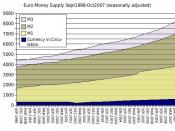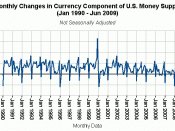In a quote by a famous American baseball player, Yogi Berra summarizes inflation very succinctly:
"A nickel ain't worth a dime anymore."
Inflation is the general increase in the price levels of goods and services. It is an economy-wide phenomenon that concerns the value of the economy's medium of exchange. Whether it be by the price of a basket of goods and services or by the measure of the value of money, inflation can be viewed in one of two ways:
(1)When the price level rises, people have to pay more for the goods and services they buy.
(2)When the price level rises, it lowers the value of money because each dollar now buys a smaller amount of goods and services.
An important concept in understanding inflation is how the value of money is determined. Just like any other commodity, it is set by supply and demand.
The supply of money is determined by the Federal Reserve, along with the banking system.
They use the three tools of monetary policy (open-market operations, reserve requirements, and the discount rate) to increase or decrease the amount of money available. Because the Fed can more or less fix the quantity of money available, the supply curve is vertical.
The demand of money is determined by how much wealth people want to hold in liquid form. People hold money because it is a medium of exchange for them to purchase goods and services. The more it costs to buy something, the more of a demand there is for money. Therefore, the demand curve slopes downward because when the value of money is low and the price level is high, people need a greater amount for them to buy goods and services so they demand more.
In the long run, the overall level of...


